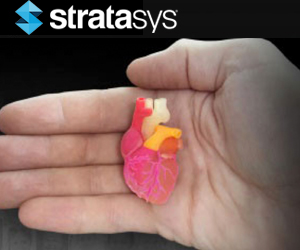OpHeart, a nonprofit organization that aims to provide the best possible care for children born with life-threatening heart defects, has become a crusader for normalizing 3D printing medical practices across health care institutions. OpHeart’s founder, Anne Garcia, is spearheading fundraising efforts for patient trials and protocols to demonstrate the clinical and economic benefits of 3D printing.
Additive manufacturing has propelled advancements and has had life-changing impacts in the medical industry, resulting in improved and personalized patient care. Using Stratasys’ PolyJet 3D printing solutions, surgical teams can reproduce anatomical models that are derived from patient imaging and use those replicas to evaluate the best possible course of action for complex surgeries. Evaluation prior to surgery can increase the success of the operation and shorten the time in the operating room.

Aaron Minard of EngATech presented Garcia with a Stratasys 3D printed heart model at a recent fundraiser event for OpHeart.
Aaron Minard of EngATech presented Garcia with a Stratasys 3D printed heart model at a recent fundraiser event for OpHeart
3D printed models also serve as educational tools for medical students and offer low-cost solutions without compromising quality or accuracy.
“To have something in your hand and be able to turn it any way you want it, to be able to cut it and see the inside and physically hold it, it’s something that can’t be replicated on a computer,” said Dr. Mark Fogel, Senior Cardiologist and Director of Cardiac Magnetic Resonance Imaging at the Children’s Hospital of Philadelphia.
Personalized patient care is a fundamental principle among health care providers, but it is often associated with rising costs. 3D printed surgical planning models and guides provide that level of personalization without high operational expenses. The models can be produced quickly from patient imaging, resulting in well-prepared surgeons, optimized surgeries and fewer medical errors.

Engatech 3D printed Ariana’s heart on a Stratasys Objet Connex Multi-material 3D Printer using PolyJet digital ABS materials.
Engatech 3D printed Ariana’s heart on a Stratasys Objet Connex Multi-material 3D Printer using PolyJet digital ABS materials
Garcia’s passion was driven from her personal experience. Last year, her then-six-week old daughter, Ariana, had emergency surgery to repair a rare, congenital heart condition. Ariana made a full recovery, but the experience prompted Garcia to ask an important question: Why isn’t 3D printing technology readily available for surgeons during pre-surgical planning processes? “Pediatric heart surgery is the hardest thing that I can imagine a person doing. A surgeon doesn’t know what he’s going to see until he opens a child’s chest—every heart is different and every cardiopathy is different,” said Garcia.
OpHeart’s second initiative includes a push for public disclosure of outcomes. Garcia has been speaking at medical conferences to provide the patient perspective as for why 3D printing technology is needed.
“Every time I talk to a doctor or meet with a parent of a child with a medical condition, I see another need for this technology. We’re going to keep going, there’s a lot more that needs to be done,” said Garcia.
Watch the video below to learn more.
To learn more about our Stratasys line of 3D printers, please click the button below.








Leave A Comment